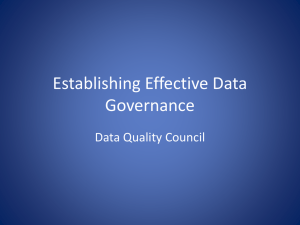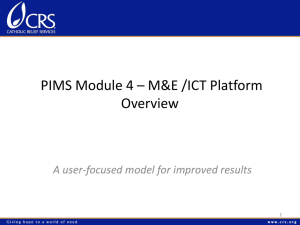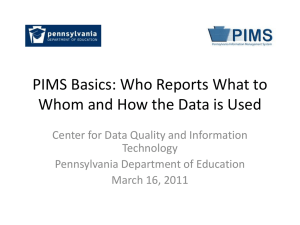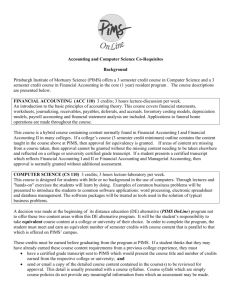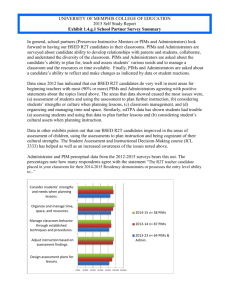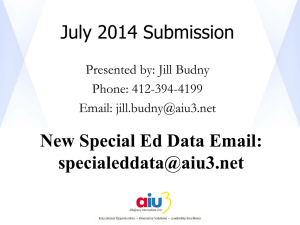PIMS Pennsylvania Information Management System
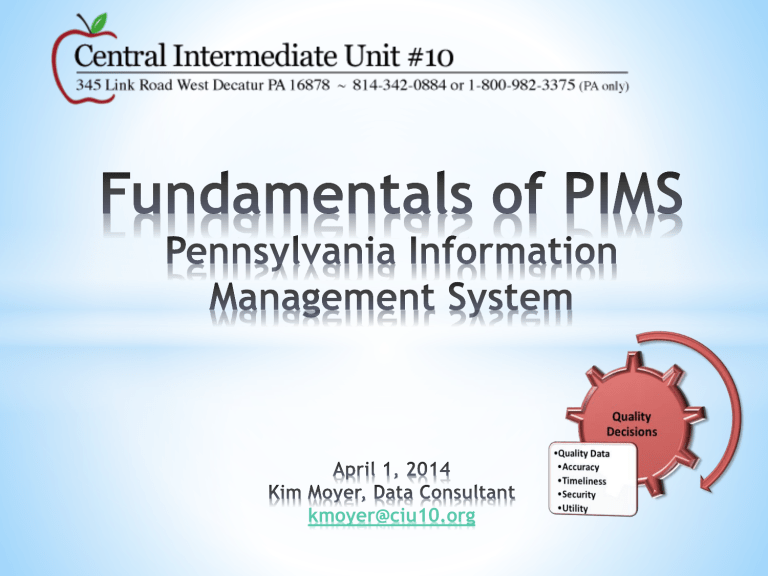
kmoyer@ciu10.org
Name and Position
LEA
What SIS do you use?
Experience w/PIMS
Concerns/Frustrations
What do you hope to gain from this class?
Introduction to PIMS
Central Intermediate Unit #10
• Increased knowledge
•
Reduced concerns/frustrations
• Increased confidence when working with PIMS data
•
Increased understanding of
• the collection process
• the importance of data collected in PIMS
• templates and field requirements o Formatting o Key fields vs. updateable fields
• validating and correcting data
• available resources
Introduction to PIMS
Central Intermediate Unit #10
Introduction to PIMS
Central Intermediate Unit #10
Data collection is not going away.
We need to plan, manage, and navigate.
Not specific to any particular collection or student information system.
Introduction to PIMS
Central Intermediate Unit #10
The Pennsylvania Information Management System
(PIMS) is a collaborative effort of the Pennsylvania
Department of Education (PDE) and the Local
Education Agencies (LEAs) across the
Commonwealth. PIMS is a statewide, longitudinal
data system that will efficiently and accurately
manage, analyze, disaggregate, and use
individual student data for each student served
by Pennsylvania’s Pre-K through Grade 12 public education system.
Introduction to PIMS
Central Intermediate Unit #10
The Pennsylvania Department of Education's statewide longitudinal data system is improving data capabilities by enhancing school districts' capacities to meet student-level data reporting requirements and provide robust decision support tools. PIMS is based on open internet standards that enable sharing among diverse, otherwise incompatible systems and includes safeguards for data quality and security.
Introduction to PIMS
Central Intermediate Unit #10
• Meet PDE and Federal reporting regulations
• Improve education decision-making through the use of high quality data
• Improve student achievement through more efficient and effective use of data
• Provide longitudinal tracking of education progress over time and across LEAs
• Report timely and accurate education data through standardized and ad hoc reporting capabilities
• Provide multi-year longitudinal data to help teachers and administrators address individual student needs
• Empower teachers with state-of-the-art data analysis tools to improve individual student achievement
Introduction to PIMS
Central Intermediate Unit #10
PIMS Collection Calendar 2007-08
4 “Collections” – 15 Templates
Data Collection Period Reporting Window
October 2007 10/15/07 – 11/9/07
December 2007
March 2008
August 2008
“Special” Graduation
Rate Data Request for
2006-07 “Cohort”
11/26/07 – 12/14/07
TBD
TBD
10/15/17 – 1/31/08
Snapshot Date
10/1/07
11/26/07
TBD
TBD
N/A
Introduction to PIMS
Central Intermediate Unit #10
• 20+ “Collections” + 9 “voluntary” PVAAS
• 30 “Templates”
• From 4x per year “project” to a year-round, constantly evolving full-time job
• Multiple Collections Open at a Time
• Every Collection has a Different Purpose
• 2013-14 Collection Calendar
• PIMS Manual Vol. 1 & 2 (2007-08 Vol. 1, 160 pgs.; Vol. 2, 94 pgs.) – 254 pages
• 2013-14 PIMS Manual – Vol. 1 364 pgs.; Vol. 2
179 pgs. – 543 pages
Introduction to PIMS
Central Intermediate Unit #10
An education LDS is a data system that:
• collects and maintains detailed, high-quality, student- and staff- level data;
• links these data across entities and over time, providing a complete academic and performance history for each student; and
• makes these data accessible through reporting and analysis tools.
Introduction to PIMS
Central Intermediate Unit #10
• Unique identifier for every student (anonymous)
• School enrollment history, demographic characteristics, and program participation record of every student
• Entry/Withdrawal, transfers, drop out, graduate information
• A way to identify teachers and to match teachers to their students
• Course enrollment information
• Ability to share data from preschool through postsecondary education data systems
Introduction to PIMS
Central Intermediate Unit #10
http://nces.ed.gov/programs/slds/state.asp?sta
teabbr=PA http://www2.ed.gov/about/inits/ed/edfacts/in dex.html
Introduction to PIMS
Central Intermediate Unit #10
Benefits
Consistency Across Districts/States
Provides a Uniform Platform for Reporting
Validations & Business Rules Lead to Cleaner Data
Challenges
System Coordination
Keeping up with Changing Requirements
Resources (Time and Staff)
Training
Data Quality & Validation
Introduction to PIMS
Central Intermediate Unit #10
• School Districts
• Intermediate Units
• Career and Technology Centers
• Charter Schools (including Cyber Charter)
• Private Residential Rehabilitation
Institutions (PRRI)
• Approved Private Schools (APS)
• State Juvenile Correctional Institutes
Introduction to PIMS
Central Intermediate Unit #10
•
Student Data
• Students to be Reported in PIMS (Vol. 1 – pg. 13)
• Student Template (Vol. 1 – pg. 260)
• Student Snapshot Template (Vol. 1 – pg. 292)
• Follow Collection Specific Rules for Which
Students to Include
• Follow Definition Specifications and Business
Rules Guidance
• Are the fields R, CR, or O?
•
Are the fields a K, U, M, N/A, etc.?
Introduction to PIMS
Central Intermediate Unit #10
What information is reported in the Student Template?
• Student ID - PA Secure ID #
• Location Code
• Grade Level
• Homeroom
• Birthdate
• Gender
• Address
• Guardian Relationship
• Ethnicity Code
• Free/Reduced Participation
• Free/Reduced Eligibility
• Special Ed. Information
• Disability Type
• ELL Information
• Repeating Last Year
• Gifted
• Expected Graduation Year
• Diploma Type
• Economically Disadvantaged Status
• ADA Status
Introduction to PIMS
Central Intermediate Unit #10
• Grade 9 Entry Date
• District Entry Date
• School Entry Date
• State Entry Date
• Date First Enrolled in US School
• Student is a Single Parent
• Home Language Code
• Years in US Schools
• District Code of Residence
• Location Code of Residence
• Funding District Code
• Graduation Status Code
• Expected Post Graduate Activity
• Displaced Homemaker
• Assessment Participation Code
• Staff Data
• Staff to be Reported in PIMS (Vol. 1 – pg. 17)
• Staff Template (Vol. 1 – pg. 215)
• Staff Snapshot Template (Vol. 1 – pg. 231)
• Staff Assignment Template (Vol. 1 – pg. 248)
• Staff Development Template (Vol. 1 – pg. 256)
• Follow Collection Specific Rules
• October Staff Collection rules may be different from
January Course/HQT Collection rules for Staff
• Follow Collection Specific Rules for Which Staff to
Include
• Follow Definition Specifications and Business Rules
Guidance
• Are the fields R, CR, or O?
• Are the fields a K, U, M, N/A, etc.?
Introduction to PIMS
Central Intermediate Unit #10
What information is reported in the Staff Templates?
• Staff ID - PPID #
• Professional Staff Only
• Location Code
• Job Description Code
• Full Time/Part Time Status
• Gender
• Race/Ethnicity Code
• Address
• Current Service Date (Hire Date)
• Exit Date
• Years Experience
• Birthdate
• Active/Inactive Indicator
• Years Experience in District
• Job Classification (PE, TPE, etc.)
• Annual Salary
• Termination Code (Reason for exit)
• Contract Information
• Name
• Highest Degree Earned
• Email Address
• Employment Eligibility Verification
Code
• Authorized to Carry a Weapon
• Assignment Code
• Assignment Date
• Completion Date
• Percent Time Assigned
• Staff Development Info if School
Security Officer
Introduction to PIMS
Central Intermediate Unit #10
• Course Data
• Courses to be Reported in PIMS (Vol. 1 – pg. 19)
• Course Template (Vol. 1 – pg. 56)
• Course Instructor Template (Vol. 1 – pg. 63)
• Staff/Student/Course Template (Vol. 1 – pg. 68)
• Core Courses Only Required (change from prior years)
• Course Codes (Vol. 2 – Appendix A)
• NCES Course Classification System
• http://nces.ed.gov/pubsearch/pubsinfo.asp?pubid=2007341
• PDE Portal>>PIMS>>PIMS Documents>>Course HQT Mapping
6.13.13
• Follow Collection Specific Rules for Courses to Include
• Follow Definition Specifications and Business Rules
Guidance
• Is the field R, CR, or O?
• Is the field a K, U, M, N/A, etc.?
Introduction to PIMS
Central Intermediate Unit #10
What information is reported in the Course Templates?
• Course Name
• Honors Indicator
• Course Length (Quarter, Semester)
• Local Course Code
• Course Delivery Method
• PA State Course Code
• Required Course?
• College Credit Indicator
• AP Indicator
• CTE Indicator
• Gifted Indicator
• IB Indicator
• Primary Instructor ID
• Section Code
• Primary Language of Instruction
• Student ID
• Student District Code
• Course District Code
• Course Location Code
• Relationship Start Date
• Instructional Responsibility Weight
• Instructional Relationship Weight
* New 2013-14 - Establishing a linkage for each student and teacher course enrollment.
Introduction to PIMS
Central Intermediate Unit #10
•
School Calendar Information/Instructional Minutes
• Attendance/Child Accounting
•
Enrollment (Enrolls/Withdraws)
• Grad/Dropout Info
•
Economically Disadvantaged
• Special Education Data
•
Immigrant Data
• ELL Data
•
Truancy
• Safe Schools Infractions
•
Discipline – Suspensions/Expulsions
• Special Programs
•
Title Information
• Special Education
•
Career and Tech. Ed. (CTE)
• Interscholastic Athletic Opportunities (Title IX)
•
Technology Information (PATI)
Introduction to PIMS
Central Intermediate Unit #10
• Cohort Graduation Rate and Dropout Rate
• Pre-code Labels for PSSA, Keystone Exams, CDT Uploads
• Accountability Reporting – PSSA, Keystone Exams, CDT Uploads,
PVAAS Uploads
• English Language Learners – ACCESS for ELLs (Title III)
• Title I Reporting
• Safe Schools Statistical Reporting
• Special Education Reporting – IDEA Funding
• Career and Technical Education (CTE) Subsidies
• October 1 Enrollment Data Reporting
• Child Accounting Subsidies
• Federal Highly Qualified Teacher Status
• School Performance Profile
Introduction to PIMS
Central Intermediate Unit #10
October 1 Enrollment Collection
• Used for planning and policy development (State & Federal)
• “Official” Enrollment for School Year
• Low Income Determination
• Official Poverty Count - Field 88 (Poverty Code) in Student Template –
Determined by LEA
• Official Free/Reduced Lunch Count
•
Field 33 (Ec. Status) – Participation in F/R Lunch Program
• Field 131 (Food Prog. Elig.) – Eligible for F/R Lunch Program
• Title I (2013-14 PIMS – no eGrants)
• Teacher Loan Forgiveness Program (30.1% Poverty Level)
• Limited English Proficiency (LEP) (2013-14 PIMS – no LEP System)
•
Title III Funds
Introduction to PIMS
Central Intermediate Unit #10
Child Accounting (Including what other LEAs report for you)
• State Subsidies
•
Basic Education Funding
• Special Education Funding (different from 12/1 Child Count for Feds)
•
Tuition for Orphans Subsidy (1305/1306/Homeless)
• Secondary Career & Technical Education Subsidy (Approved Reimbursable
Programs – CTE Collection)
• Membership Data Used to Calculate District Tuition Rate
• Weighted Average Daily Membership (WADM)
• Used in calculation of aid ratios for State subsidies
• Average Daily Attendance (ADA)
• No Child Left Behind (NCLB)
•
Adequate Yearly Progress (AYP)
• School Report Card
• School Performance Profile
• Federal ADA Report
Introduction to PIMS
Central Intermediate Unit #10
Educator Effectiveness (Student/Teacher/Course Linkage)
• Roster Verification
• Teacher Evaluations – 15% based on student growth
School Performance Profile
• Public Perception (Student Growth, Courses of Rigor, Grad/Dropout
Rates, Attendance, Promotion Rate, Post Grad. Activity)
• Data is Published
• Transparency
Educator Dashboard & Early Warning System (Proposed)
• Use PIMS Data to Identify Students At Risk of Dropping Out
• Curricular, Instructional, and Program Decisions
• Use a Catalog of Effective Differentiated Instruction & Interventions
Introduction to PIMS
Central Intermediate Unit #10
State and Federal Reporting Requirements
PDE Stakeholders:
Funding
State Performance
Plan Indicators
PDE Initiatives:
Educator
Effectiveness:
Roster Verification
PDE Initiatives:
School
Performance
Profile
PIMS
Upload and Validation
District Data
Systems
• Student Information System (SIS)
• Human Resources System
• Special Education Software
• Data Tracked Manually or in Side Spreadsheets
• Location Fact Templates
• District Fact Templates
• Who enters the data?
• Who checks the data?
• Who is responsible for the data?
Introduction to PIMS
Central Intermediate Unit #10
Student
Information
Food
Servces
Transportation Staff benefits Library
School
Messenger
Teacher
Information
Financial
Special
Education
Health
Community
Communication
Spec.
Ed.
Food
Service –
Ec. Dis.
Special
Programs
Title I SIS
ELL/
Title III
Courses
OOD
Placements
Attendance
Safe
Schools
HR
(Staff)
Teacher of Record,
Instructional Resp./Rel.
Leaves,
Vacancies, Subs
Homebound Truancy
Discipline, Suspensions, Expulsions,
LLE Involvement
Title IX
Interscholastic
Athletic
Opportunities
Introduction to PIMS
Central Intermediate Unit #10
http://www.portal.state.pa.us/portal/server.pt/comm unity/pimspennsylvania_information_management_system/8959 http://www.ciu10.org/Page/1135
Calendar may change throughout the year – check
PDE’s web site on the PIMS page for updates.
Introduction to PIMS
Central Intermediate Unit #10
Each collection may have:
•
Collection Window – Time period in which the data has to be submitted
•
Snapshot Date – A date uniquely identifying the data:
True Snapshots vs. Identity Snapshots
•
Correction Window – When uploaded data can be corrected
•
ACS Due Date – Accuracy certification Statement Due
Date
Introduction to PIMS
Central Intermediate Unit #10
• Pre-Code for winter Keystones and Classroom Diagnostic Testing
• Voluntary PVAAS enrollment (new 13-14)
• District and School Enrollment
• Staff
• PATI
• PSSA Pre-Code/ACCESS for ELLs Pre-Code and updates for Winter Keystone and CDT uploads
• Special Education
• Course/Highly Qualified Teacher
• Pre-Code for Spring Keystone Exams and additional CDT Student uploads
• English Language Learners… ACCESS for ELL
Introduction to PIMS
Central Intermediate Unit #10
• Child Accounting – SD & IU Preliminary Juveniles incarcerated in Adult Facilities
• Accountability Reporting: PSSA Student Upload
• Safe Schools
• Graduates, Drop outs and Cohort
• Accountability Reporting: Spring Keystone exams and CDT Student uploads
• Pre-Code Student upload for summer Keystone exams
• English Language Learners – End of Year (Count and /SES Provider)
• Child Accounting – End of Year
• Special Education Updates
• Career and Technical education
• Interscholastic Athletic Opportunities
• LEP Professional Activities Survey
• SES/School Choice
• Title 1 Staff and Student Participation Data
Introduction to PIMS
Central Intermediate Unit #10
The shoes are great…but watch out for those falling houses.
Introduction to PIMS
Central Intermediate Unit #10
• 1 or more templates with predefined data fields
• Must follow business rules
• Must follow a submission sequence
• Data must be formatted according to PIMS Manual
• Some data fields must be blank
• Student Template contains 202 data fields – how many students do you have?
• 1000 students x 202 data fields = 202,000 potential points of error in just one template
Introduction to PIMS
Central Intermediate Unit #10
• Course
• Course Instructor
• CTE Student Fact
• CTE Student Industry Credential
• District Fact
• District Snapshot
• Incident
• Incident Offender
• Incident Offender Disciplinary Action
• Incident Offender Infraction
• Incident Offender Parent Involvement
Introduction to PIMS
Central Intermediate Unit #10
• Incident Victim
• Location Fact
• PATI LEA Tech Survey
• PATI School Tech Survey
• Person
• Program Fact
• School Calendar
• School Enrollment
• Special Education Snapshot
• Staff
• Staff Assignment
Introduction to PIMS
Central Intermediate Unit #10
(cont’d.)
(cont’d.)
• Staff Development
• Staff Snapshot Template
• Student
• Student Calendar Fact
• Staff Student Course Template (new 13-14)
• Student Snapshot
• Survey Participant Response Template
Introduction to PIMS
Central Intermediate Unit #10
• Fields have specific business rules, specific formats, value lists
• Fields in your data systems map to the PIMS fields
• Data validation and error correction should occur on entry to your data system prior to upload
• ALWAYS correct the source vs. correcting the template!!
• Many different departments in your district are responsible for entering data into your district data systems that flow into PIMS
• Human Resources
• Central/Building registration
• Child accounting
• Special Education
Introduction to PIMS
Central Intermediate Unit #10
• Multiple collections may be “Open” at the same time.
• The collection windows are short and fixed in length
• If key field data is submitted incorrectly the data cannot be updated.
• Corrections take time and must go through PDE
• Validate and correct data all the time – checks and balances – do not wait for a submission
• The PIMS requirements change every year
• Templates change, new collections added, different collection windows, new fields and code values -- your PIMS
Administrators and data staff are continually learning
Introduction to PIMS
Central Intermediate Unit #10
• The Superintendent must sign off on EVERY ACS!
• Every Collection has its own ACS
• How do you know each ACS is right?
• Who knows how to verify each section of the ACS?
• What checks and balances do you have in place to ensure the ACS is accurate?
• Year to Year comparisons
• Internal ACS
• Team Approach to Verification
Introduction to PIMS
Central Intermediate Unit #10
• PIMS Manual – Vols. 1 & 2
• PIMS Collection Calendar
• PIMS Web Site
• PIMS Documents
• EdNA
• PDE Webinars – www.pdewebinars.org
• Collection Experts at PDE (contact info handout)
• SIS Vendor ****
• Intermediate Unit
• Data Quality Curriculum (PDE & IUs)
Introduction to PIMS
Central Intermediate Unit #10
“Domains, and Templates, and Snapshots…..
Oh, my!”
Introduction to PIMS
Central Intermediate Unit #10
• New Data Flow Process – Up Front Edit Checks
• Additional Validation Layer Between File Manager & Batch
Manager Verifications in PIMS Upload Process
• Compound Data Quality Checks
• Validations on a single row or within a single template
• Advanced Data Quality Checks
• Validations across templates, query the data warehouse, or query groupings in a single template. Validate across systems and across years.
• All templates for a collection must be “batched” together
• Data Exception Requests
• Always Correct the Source System
Introduction to PIMS
Central Intermediate Unit #10
• Domains – How information is organized/categorized in PIMS.
• Templates – The “vehicle” used to “transport” data into a PIMS domain. Templates possess a standard layout and ensure a consistent pattern of data rules are followed.
• Snapshots – A subset of template data at a “point in time.”
(“true” snapshots vs. snapshots)
• Collections – A set of templates submitted to PIMS throughout the school year, according to a pre-determined data collection calendar.
Introduction to PIMS
Central Intermediate Unit #10
• File Manager - Uploads data to the PIMS system and performs basic validation
• Batch Manager - Loads data that has passed validation rules into the PIMS warehouse
• Data Quality Engine (new this year) - Front end data validation against business rules that the data has to pass before it can be loaded in to PIMS
• Cognos – The PDE reporting system used to create data reports, data extracts and create the accuracy certification statements
Introduction to PIMS
Central Intermediate Unit #10
• PIMS Manual Vol. 1 – pg. 28-31 (Handout)
• Follow Definition Specifications and Business Rules
Guidance
• Are the fields R, CR, or O?
• Are the fields a K, U, M, N/A, etc.?
• File Dependencies
• Student or Staff Template – Cumulative
• Student Snapshot or Staff Snapshot
• If a student/staff is in the Student or Staff Snapshot Template, he/she must also be in the Student or Staff Template BUT a student/staff can be in the Student or Staff Template without being included in the Student or Staff Snapshot Template
Introduction to PIMS
Central Intermediate Unit #10
Naming convention is specified in the PIMS Manual at the beginning of the description about each template.
Proper Format: District Code_TargetTable_YYYYMMDDHHMM.xxx
District Code = 9-digit Administrative Unit Number (AUN) Ex: 110000000
Target Table = Name specified with template from PIMS Manual Ex: Student
Time Stamp = Date and time (ensures uniqueness of file – no template can be uploaded to PIMS if a template with the same name has been uploaded prior) xxx = File Extension, indicates type of data separator Ex: csv, tab, del csv = comma separated tab = tab separated del = other delimiter
Introduction to PIMS
Central Intermediate Unit #10
• DQE Simulation – Located on PDE Site
Introduction to PIMS
Central Intermediate Unit #10
Introduction to PIMS
Central Intermediate Unit #10
• Be Proactive!
• Listen to the PDE training for each collection if offered.
• Review the PIMS Manual guidelines for each collection.
• Review the PIMS Collection Calendar.
• You should be able to answer the following questions.
o Who should be included? (Which students or staff?) o What is the purpose of this collection? Remember that every collection is for a different purpose even if it uses the same template as another collection.
o What are the key fields for this collection?
o When is the collection window?
o What district events or calendar events may conflict with this window?
o Is there a correction window? If so, when?
o Where is the data stored? Is it current?
o Is there a Snapshot date required or is this a cumulative collection?
Introduction to PIMS
Central Intermediate Unit #10
o If it’s a Snapshot, is it a “true snapshot” or is a “time stamp” to identify the collection?
o How do I extract the data from my SIS or other system?
o Who enters the data? Is it complete and up to date?
o Who owns (is responsible for) the data?
o Who will verify the data and correct, if necessary?
o When is the Accuracy Certification Statement (ACS) due?
• Look at your data before you upload. Take team approach to resolution of discrepancies.
• PIMS HelpDesk – 1-800-661-2423.
Introduction to PIMS
Central Intermediate Unit #10
• Significant Issues with Data Quality in Previous Years
• PDE Tasked IUs to Provide Assistance to LEAs for:
• Timely and Accurate Data Collection
• Implementing and Sustaining Data Governance and Data
Best Practices
• Facilitate Monthly Data Quality Network Meetings
• Assist LEAs With Data Quality Engine (DQE) Use (Goes
“LIVE” October 1) – Front End Data Validations
•
Conduct Training for PDE’s “Data Quality Curriculum
Program” (Tentative Roll Out Spring/Summer 2014)
Introduction to PIMS
Central Intermediate Unit #10
• Tracks:
• Entry Level PIMS Administrators
• PIMS Administrators
• LEA Administrators
• Data Entry
•
Specialty Modules:
• Data Quality Engine
• PA Secure ID
• School Performance Profile
• Teacher-Student Data Linkage/Educator Effectiveness
• Special Education
• Child Accounting
• Career and Technology Education
Introduction to PIMS
Central Intermediate Unit #10
• Goals:
• Reduce data-related errors in federal and state reporting
• Reduce data-related errors and inaccurate reporting that can lead to reductions in funding
• Increase the quality of the data that will be used for evaluation purposes, such as the School Performance Profiles
• Increase understanding of critical issues such as FERPA, data relationships and best practices
• Create an effective and enterprise-wide culture of data quality
• Improve the quality, timeliness and understanding of the data used for educational reporting, decision-making and school/student improvement
Introduction to PIMS
Central Intermediate Unit #10
Quality Data Culture Concept Map
(expanded)
Timeliness
Utility
Accuracy
Superintendent
Board
Member
Security
Components of a Quality
Data Culture
Data
Steward
Roles in a
Quality
Data
Culture
Principal
Introduction to PIMS
Technology
Central Intermediate Unit #10
Support
Staff
Policies and
Regulations
Standards and
Guidelines
Quality
Data
Culture
Factors
Affecting a
Quality Data
Culture
Timelines and
Calendars
Training and
Professional
Development
Technology
Hardware
Software
Network
Data Entry
Environment
More Effective
Decision-Making
Teacher
Importance of a Quality
Data
Culture
Achieving
AYP
Office
Staff
Program
Funding
Other
Introduction to PIMS
Central Intermediate Unit #10
Introduction to PIMS
Central Intermediate Unit #10
Introduction to PIMS
Central Intermediate Unit #10
Introduction to PIMS
Central Intermediate Unit #10
December 12, 2013
Introduction to PIMS
Central Intermediate Unit #10
Introduction to PIMS
Central Intermediate Unit #10
Introduction to PIMS
Central Intermediate Unit #10
Introduction to PIMS
Central Intermediate Unit #10
Introduction to PIMS
Central Intermediate Unit #10
Introduction to PIMS
Central Intermediate Unit #10
Introduction to PIMS
Central Intermediate Unit #10
December 12, 2013
“Data matters now in a way it has never mattered before in PA.”
~~ Dr. Michele Sellitto, Special Assistant to the Secretary of Education, PDE
A/CAPA Conference – SPP Presentation, March 2014
Introduction to PIMS
Central Intermediate Unit #10
“Quality is never an accident; it is always the result of high intention, sincere effort, intelligent direction and skillful execution; it represents the wise choice of many alternatives.”
~~William A. Foster
Introduction to PIMS
Central Intermediate Unit #10
